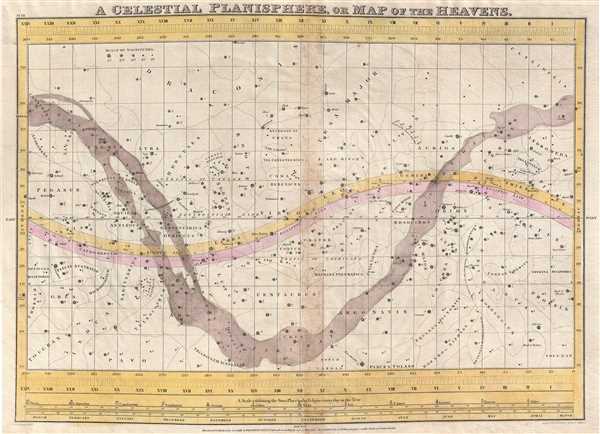
This item below is out of stock, but another example (left) is available. To view the available item, click "Details."
Details
1833 Burritt / Huntington Map of the Heavens or A Celestial Planisphere
1833 (dated) $350.00
1833 Burritt - Huntington Map of the Heavens or A Celestial Planisphere
Heavens-burritt-1833
Title
1833 (dated) 15.5 x 21 in (39.37 x 53.34 cm)
Description
The map was engraved Illman and Pilbrow under the direction of E. H. Burritt and issued as plate no. VII in the 1833 first edition of F. J. Huntington's Atlas, Designed to Illustrate the Geography of the Heavens. There are several editions of this atlas, the most common being the 1835 by Burritt. Only the earliest editions are colorized.
CartographerS
Elijah Hinsdale Burritt (April 20, 1794 - January 3, 1838) was an American astronomer and mathematician active in Connecticut. Burritt is often called 'the forgotten astronomer.' Burrito was born to an impoverished family and was initially apprenticed as a blacksmith. After an injury on the job, Burritt turned to astronomy with a passion. He studied at Williams Collage, from which he graduated in 1816. After graduation he moved to Milledgeville, then capital of Georgia. He taught at local schools for several years but, being a northerner, began to feel uncomfortable as his 'yankee attitudes' alienated his peers. He returned to Connecticut in 1829 and turned his parents home into an observatory to pursue his love of astronomy. Burritt then organized a group of 30 settlers to relocate to the newly formed Republic of Texas. There, Burritt and many of his fellow settlers contracted Yellow Fever and died. His seminal work, Burritt's Geography of the Heavens was published from Hartford, Connecticut, in approximately 1833. The work, while primarily educational in nature, was the seminal American geography of the period. Much of the nomenclature they developed, especially regarding the visible stars and constellations of the Southern Hemisphere, is still in use today. The atlas itself consisted of eight charts depicting the heavens seasonally and hemispherically. Constellations were depicted figurally, though only the most important stars were noted. The Geography of the Heavens was the last decorative celestial reference in the 19th century. Burrit's geography was among the most prized possessions of fantasy / horror writer H.P. Lovecraft who wrote:
"My maternal grandmother, who died when I was six, was a devoted lover of astronomy, having made that a specialty at Lapham Seminary, where she was educated; and though she never personally showed me the beauties of the skies, it is to her excellent but somewhat obsolete collection of astronomical books that I owe my affection for celestial science. Her copy of Burritt's Geography of the Heavens is today the most prized volume in my library." (to Maurice W. Moe, 1 January 1915)As a side note Elijah Burritt is the brother of the more famous Elihu Burritt, known for his philanthropic and social work. More by this mapmaker...
Thomas Illman (fl. c. 1824 – 1858) was an English engraver active in New York City during the early 19th century. Illman was born in England and attended Trinity College in Oxford where he attained a degree in theology. Despite initial religious fervor, he soon became an atheist. Professionally he turned to engraving to support his artistic tendencies. In London he mastered the engraver's art. His first paying work as an artist was illustrating for Thomas Carlyle's Confessions of an English Opium Eater. He relocated to New York City in 1828, almost immediately partnering with Edward Pilbrow to found the firm Illman and Pilbrow. Illman and Pillbrow were almost immediately hired by David H. Burr to engrave maps for his Universal Atlas, which he began working on in that year. When Burr took a position as topographer and cartographer for the United States Post Office, he ceded all remaining work on the Atlas to Illman and Pilbrow. In addition to his atlas work, Illman privately pursued his own art as well as engraved portraits and landscapes. He was admired as a skilled line, stipple, and mezzotint engraver. At some point he may have relocated to Philadelphia. His sons, H. Illman and G. Illman followed in his footsteps founding Illman Sons in 1845 Learn More...

